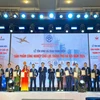 Vietnam’s garment and textiles export in the first half of the year grew 11.3 percent year-on-year to 14.58 billion USD (Source: VNA)
Vietnam’s garment and textiles export in the first half of the year grew 11.3 percent year-on-year to 14.58 billion USD (Source: VNA) Hanoi, July 4 (VNA) – Vietnam’s garment and textiles export in the first half of the year grew 11.3 percent year-on-year to 14.58 billion USD. However, experts said the growth has not been sustainable yet.
Le Tien Truong, Deputy General Director of the Vietnam Garment and Textile Group (Vinatex), said the results proved a praiseworthy effort made by the garment sector in the context of the unstable global economy.
Demand for textile products from key importers like the US, the EU and Japan tapered off in the first six months of the year. However, Vietnam’s garment exports to those markets experienced robust achievements, Truong said.
He said that the country earned 6 billion USD from exports to the US, surging nearly 9 percent, 2.3 billion USD from shipments to the EU, up 8 percent and 1.5 billion USD from Japan, up 12 percent.
Vietnam outstripped its competitors in garment export growth in the period. According to the Trade Map, China experienced a decline of more than 5 percent year-on-year, while Bangladesh saw a drop of 3.5 percent and Indonesia, 5 percent.
However, the trade protectionism policy of the US President Donald Trump administration and interest rate adjustment from the US Federal Reserve will threaten sustainable export growth. There is a high possibility that Vietnam’s competitors will further devaluate domestic currencies to support exports as they did in 2016, Truong said.
As the most tremendous hurdle for Vietnamese garments is foreign competitors, especially China with large scale production and low costs, Vietnamese enterprises need to join the global supply chain with fastidious requirements of quality, prices and time of good delivery.
Poor orientations, which fail to meet long-term development of local enterprises, are a great inner difficulty for the garment and textiles industry. In addition, unsound competition between domestic and FDI businesses has been on the cards.
The shortage of high-quality human resources, limitations in product development, capital access, marketing and foreign languages and high input costs also challenge the sector.
The garment sector recommended relevant authorities to support training programmes in original design manufacturer (ODM) business and information and technology while outlining rational policies on job creation, minimum wages and exchange rate.
Creating favourable conditions for enterprises to get access to soft loans and preventing smuggled goods are significant activities to support domestic garment and textiles businesses.-VNA
VNA





















